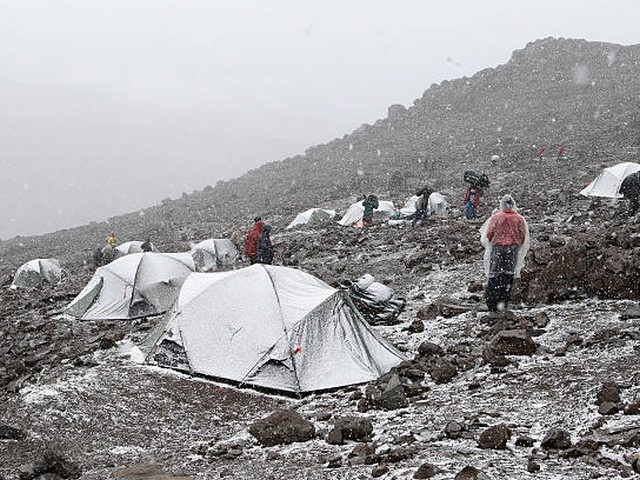Preventing Frostbite and Hypothermia on Kilimanjaro: A Guide to Safe Summit Success
Scaling the mighty Mount Kilimanjaro is a dream many hold close to their hearts. This majestic mountain, standing as a beacon of challenge and triumph, calls to adventurers from around the globe. However, the journey up the highest peak in Africa is not without its perils. Among these, frostbite and hypothermia are significant risks that can turn a dream expedition into a daunting ordeal. At Kilimanjaro Centre for Trekking and Ecotourism (KCTE), we believe that preparedness is the key to not just reaching the summit, but enjoying every step of the journey. Let us guide you through effective strategies to prevent frostbite and hypothermia, ensuring a safe, exhilarating climb.
Understanding the Risks: Frostbite and Hypothermia on Kilimanjaro
What You Need to Know
Before embarking on your Kilimanjaro adventure, understanding the risks of frostbite and hypothermia is crucial. Frostbite occurs when skin and other tissues freeze due to exposure to very cold temperatures. Hypothermia, on the other hand, happens when your body loses heat faster than it can produce it, causing body temperature to fall dangerously low.
Kilimanjaro's high altitude and equatorial location can deceive climbers. The mountain's peak, Uhuru Peak, sees temperatures that can plummet to below freezing, especially at night. Coupled with biting winds and thinning air, the unprepared climber can face significant risks.
Gear Up: Choosing the Right Equipment
Layer Wisely
The secret to comfort and safety on Kilimanjaro lies in layering. Start with a moisture-wicking base layer that keeps sweat away from your skin. Add an insulating layer, preferably made of fleece or down, that traps heat efficiently. Your outermost layer should be windproof and waterproof, shielding you from the elements. Don't forget insulated gloves, a warm hat, and thermal socks. Quality hiking boots with insulation are essential to prevent frostbite on your feet.
High-Tech Help
Consider investing in high-tech gear such as battery-heated gloves and socks. These can provide adjustable levels of heat, offering an extra defense against the cold. Remember, however, that technology should complement, not replace, good quality basic gear.
Climbing Smart: Tactics to Stay Warm
Keep Moving, Stay Warm
Maintaining a steady pace helps keep your body temperature regulated. However, avoid overexertion, which can lead to sweating and subsequent chilling when the sweat cools off. Take regular breaks in sheltered spots to rest without losing too much body heat.
Stay Hydrated and Energized
Hydration and proper nutrition are your allies against the cold. Dehydration can make you more susceptible to frostbite and hypothermia. Drink water regularly throughout your climb. Eating high-energy, high-calorie foods can also help your body generate heat.
Recognize and Respond: The First Signs of Cold Injuries
Know the Signs
The first signs of frostbite include numbness, tinged skin (white, red, or yellow spots), and hard, waxy skin. Hypothermia signs include shivering, exhaustion, confusion, and slurred speech. Recognizing these early can be life-saving.
Take Immediate Action
If you suspect frostbite or hypothermia, act quickly. Find shelter, replace wet clothing, and rewarm the body gradually. Do not rub frostbitten areas as this can cause more damage.
Why Choose KCTE for Your Kilimanjaro Climb?
At Kilimanjaro Centre for Trekking and Ecotourism, we prioritize your safety and enjoyment. Our guided tours are led by experienced, knowledgeable guides trained in first aid and emergency response, equipped to handle the unique challenges of high-altitude climbing. Choosing KCTE means embarking on your Kilimanjaro journey with a team that cares deeply about your experience and well-being.
Frequently Asked Questions
What is the best time of year to climb Kilimanjaro to avoid extreme cold?
The best months to climb Kilimanjaro are typically January to March and June to October. These months offer the clearest weather conditions and minimal precipitation, reducing the risks of frostbite and hypothermia.
How can I best acclimatize to prevent altitude sickness?
Acclimatization is key to a successful climb. KCTE offers climbs that are paced to allow your body to adjust to higher altitudes gradually, reducing the risk of altitude sickness.
Can children and older adults safely climb Kilimanjaro?
Yes, with proper preparation and a reputable guide service like KCTE, people of all ages can safely climb Kilimanjaro. We tailor our treks to fit the needs of our climbers, ensuring a safe and enjoyable experience for everyone.
How physically fit do I need to be to climb Kilimanjaro?
While you don't need to be an elite athlete, a good level of baseline fitness is required. We recommend that climbers engage in a regular fitness regime well before their climb to build endurance and strength.
Embrace the Challenge, Safely
Climbing Kilimanjaro is an awe-inspiring experience that you will cherish for a lifetime. By preparing adequately, choosing the right gear, and understanding how to prevent and handle cold injuries, you set the stage for a successful summit. Remember, Kilimanjaro Centre for Trekking and Ecotourism is here to guide you to the roof of Africa, safely and joyfully. Book your Kilimanjaro climb with KCTE today, and step into the adventure you've always dreamed of!




